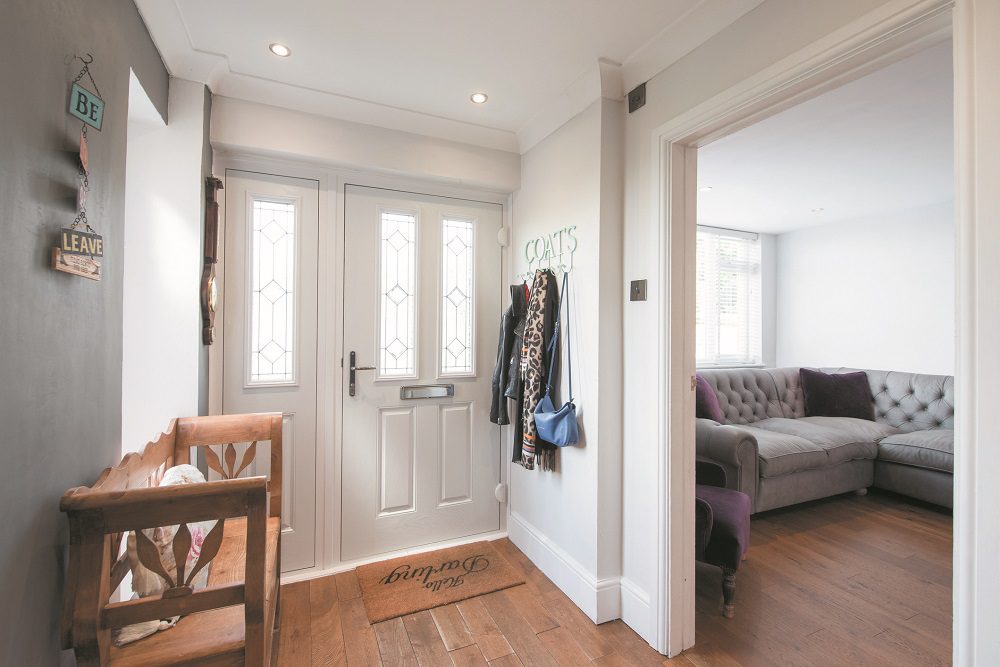The world is starting to open up again. Having guests over is slowly becoming a normal part of life, and that means focusing attention on a part of the home that has been ignored of late—the entryway.
Or perhaps you are thinking about selling your home—potential buyers form hard-to-shake first impressions of your home as soon as they step into its entryway. This space’s décor sets the mood and tone for the entire rest of the house. An uninspired entryway also can subtly undermine a homeowner’s impression of his/her own house.
Good news: Elevating the entryway décor doesn’t have to be an extended or expensive process. These relatively small spaces typically require only a few pieces of furniture. But entryways do pose a tricky design challenge—form must be carefully balanced with function. An entryway doesn’t only have to make a good first impression, it also must serve as a practical place for transitioning between outside and in. Six rules for entryway décor…
Less but larger. Rule of thumb: Don’t include more than five furniture or décor pieces in your entryway…but do pick pieces that are substantial in size.

The biggest entryway-design misconception is that because this space tends to be small, small décor pieces and patterns are appropriate. But having too many items in an entryway is distracting and works against one of the primary goals of this space—efficiently transitioning guests and homeowners between the outdoors and the home’s living space. Example: An entryway floor of large tiles with relatively few grout lines will seem cleaner and calmer than one of small tiles with lots of grout lines.
Certainly, you wouldn’t want to include very large furniture that makes it difficult to move through this area, but big pieces and patterns actually make entryways seem more complete, enveloping and psychologically comforting.

Surrounding rooms should inform entryway wall color and flooring choices. Don’t draw inspiration only from attractive entryways you visit or see in design magazines. Make wall- and floor-color decisions based on the walls of the neighboring rooms in your own home. When the walls of adjacent spaces share a color pallet, it helps them flow seamlessly together—and this sense of flow is especially important for entryways, where people spend only a few moments before moving on.
Sharing a color palette doesn’t mean an entryway must have precisely the same colors as neighboring rooms. It could instead be painted in a color that’s an undertone in the wallpaper in a neighboring room or vice versa, for example.
Matte and eggshell finishes on painted entryway walls tend to be better choices than gloss and semi-gloss finishes, which can be overly shiny and reflective if the entryway gets lots of natural light.
Entryway flooring generally should match the flooring in the surrounding space so that the spaces flow together. Exception: Choose hard flooring for an entryway even if the surrounding rooms are carpeted—footwear coming in from outside can discolor entryway carpeting.
Mirror, mirror on the entryway wall. A large wall mirror is an entryway must—you can use it to look yourself over before venturing out into the world…and your guests can do the same when they arrive at your house. A mirror even can make a compact entryway feel somewhat larger by creating an illusion of depth.
But not just any mirror will do here—a small mirror won’t offer a head-to-toe once-over or create that room-expanding illusion…and a low-end discount store mirror isn’t appropriate for such an important spot in the home. Some people think one full-size mirror is pretty much as good as the next because people look at their own reflections in mirrors, not at the mirrors themselves…but with five or fewer pieces in the entryway, every item needs to convey a sense of quality and style. Examples: Mackai Metallic Silver Leaf 23-x-32-inch Wall Mirror, $371.80…Possini Euro Leonid 28-x-40-inch Blue Rectangular Modern Wall Mirror, $269.99, both available at LampsPlus.com.

Add an organizing piece to keep the entryway tidy. Designing an attractive entryway is one challenge…preventing entryway clutter such as coats and boots from undoing those decorating efforts is another. A stylish hall organizer can control clutter and look good. Such an item is a must-have if your home lacks a roomy front hall closet…and it’s worth considering even if it does have one. These organizing units offer a range of useful options that hall closets might lack, including benches, shelves and hooks. Examples: Grandin Road Cullen Entryway Collection, a modular entryway set featuring wall panels, hooks, shelves, benches and other components—pieces can be selected to fit different entryway sizes and needs (components and kits range from $19.50 to $999, GrandinRoad.com)…Latitude Run Tyriq 74.8-inch Hall Tree with Bench and Shoe Storage, a tall coat tree with modern styling, bench and enclosed shoe storage ($1,099.99 at Wayfair.com).
Light softly from above. Entryways require a reasonable amount of illumination, but harsh lighting as soon as you step into a house can be jarring and off-putting. The ambient light of a chandelier often is the best solution—chandeliers illuminate without creating a caught-in-the-spotlight sensation. If you want additional ambient light, add wall sconces. Also: Chandeliers don’t have to look old-fashioned—there are plenty of modern options if that’s a better fit for your home. Examples: Vera 9-Light Unique/Statement Modern Linear Chandelier ($500 at
AllModern.com)…Phoebe Acrylic Chandelier ($829 at BallardDesigns.com).
Opt for a console table if your entryway is tight. Some console tables are barely more than 12-inches deep, small enough to fit even narrow entryways. These might not provide all of the clutter-containing functionality of the larger organizing pieces mentioned above, but they can be a convenient spot to drop keys, phones, gloves, mail and other small items. A console table also provides a point of focus for an entryway that is too small for larger furniture. Examples: Latte Jorn Console, 13 inches deep ($439 at InsideWeather.com)…Delphine Entryway Console, 14 inches deep ($899 at WestElm.com)…Linden 47-inch Console Table, 14.5 inches deep ($440 at AllModern.com).


